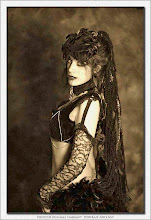I’ve received many responses to my post A Witch Who Cannot Hex, Cannot Heal, (“H” for the Pagan Blog Project). The majority have been supportive and
positive. Some people have even said that they have felt liberated by what I said.
Wow! Other people have disagreed, and that’s fine. Not everyone is going to be
comfortable with the ideas in the post.
But one argument stands out for me as totally absurd: that I shouldn't write these things
because it will give the rest of the
world the wrong impression about Witches; that it only confirms to the world
that Witches are all about curses, people will take it the wrong way...Etc.
Oh, please! Why should I be responsible for what other
people think? I can’t control that. It’s not my job to try. I don't represent all Witches everywhere, and though yes, I expect that my words could influence thought, its not my job to control the outcome of this influence. I am reminded of what’s been said a thousand times to LGBT people by other LGBT people: that they should
modify their behavior (i.e. not be too “flamboyant” or demonstrative) in order
to be “accepted” by society. Oh yank, yank, yank. How does that usually turn
out? The same has been said to every oppressed group in history, from women to
African Americans, to indigenous tribes everywhere, to Witches.
For this week’s Pagan Blog Project post, I am inspired to
write for “J”: “Is it my ‘Job’?”.
My job, and the job of Witches, is to answer to our higher
selves, and to embrace our CALLING. Not to obsess about what the neighbors will
think. I am not saying that sometimes it is not necessary to stay on the down
low for self-protection. That is survival, and I get that. But to be less than
oneself in order to “accepted”? Ha! News flash ya’ll: if you have to make
yourself smaller for anyone, they’re not going to accept you anyway. That’s how
it is, that’s how it’s always been, and that is how it will be. Don’t you think
that the witches who were hung and burned thought about modifying their
behavior to get along before they ended up on the stake or gallows? Don’t you
think that many tried this to see if maybe they could be “accepted”? Besides, you’re
not being accepted if you are changing who you are. Some charade that you are
acting out is being merely tolerated.
I had a long conversation with Laurie Cabot the other day,
as we were preparing for my interview with her about her days as a Bellydancer.
(interview to appear in Belly Dance New England magazine soon!) We talked about
this idea of one’s calling, and how it is essential that, in order to be truly
empowered to answer a calling, one MUST NOT entertain the smallness of some
minds. To do so is pointless and a waste of energy. Laurie Cabot is one who has
sacrificed a great deal to be true to herself as a Witch, as an artist, and as
a woman over many decades. Though she has paid the price, she still felt that
it was essential, for true sovereignty over one’s life as a Witch and/or simply as a human
being, that we not expend energy what “those people” say.
 Jungian psychologist James Hillman, in his book The Soul’s Code: In Search of Character and Calling, talks a great deal about the dangers
of not answering the call that comes from within. He says that we are all born
with an “acorn” (seed) or “daimon”
(not demon, read carefully, please). He asserts that when the daimon within is
thwarted for whatever reason (“acceptance” by society? “Sacrificing” for the “sake
of the kids”?) the person becomes twisted up and passes this fucked-up-ness
down into the next generations. He says that in order to have a healthy,
empowered life, one must answer the calling fully. This is not a selfish act;
on the contrary, it creates an empowered path to health that is then passed
down to those who come after. And check it out: we then become the best elders
and ancestors we can be! How about it? Win-win.
Jungian psychologist James Hillman, in his book The Soul’s Code: In Search of Character and Calling, talks a great deal about the dangers
of not answering the call that comes from within. He says that we are all born
with an “acorn” (seed) or “daimon”
(not demon, read carefully, please). He asserts that when the daimon within is
thwarted for whatever reason (“acceptance” by society? “Sacrificing” for the “sake
of the kids”?) the person becomes twisted up and passes this fucked-up-ness
down into the next generations. He says that in order to have a healthy,
empowered life, one must answer the calling fully. This is not a selfish act;
on the contrary, it creates an empowered path to health that is then passed
down to those who come after. And check it out: we then become the best elders
and ancestors we can be! How about it? Win-win.
Whatever our stance on hexing and healing, I think that it’s
a waste of time for any of us to hold back our ideas and feelings just because “we’re
not accepted in society yet.” Seriously? How long should we wait? I’m not
holding my breath. I’m going to set my intention to do my real job, which is to
be myself, fully and lovingly. Acceptance starts within.
And as within, so without.







.jpg)


















